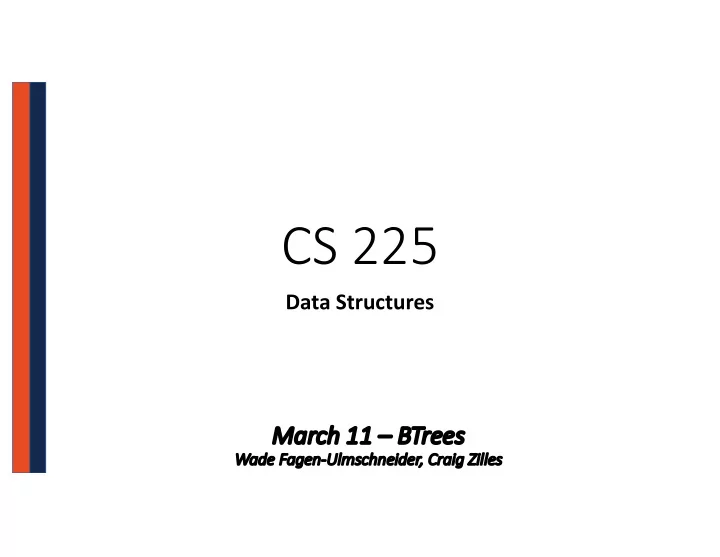

CS 225 Data Structures Mar March h 11 11 – BT BTrees Wade Fa Wa Fagen-Ul Ulmsch schnei eider er, , Cra Craig Zi Zilles
B-Tree ee Motivation Big-O assumes uniform time for all operations, but this isn’t always true. However, seeking data from disk may take 40ms+. …an O(lg(n)) AVL tree no longer looks great: 8 5 10 3 6 9 12 1 4 7 11 2
BTree ee (of order er m) -3 8 23 25 31 42 43 55 m=9 Goal: Minimize the number of reads! Build a tree that uses ______________________ / node [1 network packet] [1 disk block]
BTree ee Inser ertion A BTrees of order m is an m-way tree: - All keys within a node are ordered - All nodes hold no more than m-1 keys. m=5
BTree ee Inser ertion When a BTree node reaches m keys: m=5
BTree ee Rec ecursive e Inser ert 23 42 m=3 -3 8 25 31 43 55
BTree ee Rec ecursive e Inser ert 23 42 m=3 -3 8 25 31 43 55
BTree ee Vi Visua ualization/ n/Tool https://www.cs.usfca.edu/~galles/visualization/BTree.html
Btree ee Proper erties es A BTrees of order m is an m-way tree: - All keys within a node are ordered - All leaves contain hold no more than m-1 keys. - All internal nodes have exactly one more child than key - Root nodes can be a leaf or have [2, m] children. - All non-root, internal nodes have [ceil(m/2), m] children. - All leaves are on the same level
BTree ee 17 3 8 28 48 1 2 6 7 12 14 16 25 26 29 45 52 53 55 68
BTree ee Sea earch 23 -3 42 55 -11 8 25 31 43 60
BTree ee Sea earch 1 bool Btree::_exists(BTreeNode & node, const K & key) { 2 3 unsigned i; 4 for ( i = 0; i < node.keys_ct_ && key < node.keys_[i]; i++) { } 5 6 if ( i < node.keys_ct_ && key == node.keys_[i] ) { 7 return true; 8 } 9 10 if ( node.isLeaf() ) { 11 return false; 12 } else { 13 BTreeNode nextChild = node._fetchChild(i); 23 14 return _exists(nextChild, key); 15 } 16 } -3 42 55 -11 8 25 31 43 60
BTree ee Analy alysis is The height of the BTree determines maximum number of ____________ possible in search data. …and the height of the structure is: ______________. Therefore: The number of seeks is no more than __________. …suppose we want to prove this!
BTree ee Analy alysis is In our AVL Analysis, we saw finding an upper bound on the height (given n ) is the same as finding a lower bound on the nodes (given h ). We want to find a relationship for BTrees between the number of keys ( n ) and the height ( h ).
BTree ee Analy alysis is Strategy: We will first count the number of nodes, level by level. Then, we will add the minimum number of keys per node ( n ). The minimum number of nodes will tell us the largest possible height ( h ), allowing us to find an upper-bound on height.
BTree ee Analy alysis is The minimum number of nodes for a BTree of order m at each level : root: level 1: level 2: level 3: … level h:
BTree ee Analy alysis is The total number of nodes is the sum of all of the levels:
BTree ee Analy alysis is The total number of keys :
BTree ee Analy alysis is The smallest total number of keys is: So an inequality about n , the total number of keys: Solving for h , since h is the number of seek operations:
BTree ee Analy alysis is Given m=101 , a tree of height h=4 has: Minimum Keys: Maximum Keys:
Recommend
More recommend